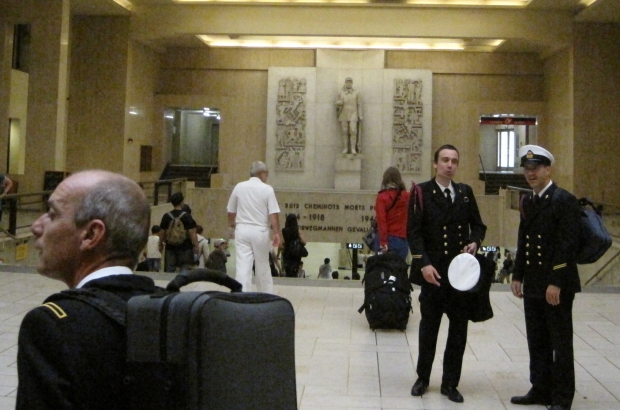- Daily & Weekly newsletters
- Buy & download The Bulletin
- Comment on our articles
The neverending commute: Brussels' Central Station
The practical necessities of travel usually allow us only rushed and distracted impressions of train stations, airports and bus depots. The true character of these transit hubs often remains obscured regardless of the frequency with which we pass through them. Some of them manage nevertheless to communicate a distinct personality to even inattentive travellers by virtue of a dominant feature or association. The impression is incomplete, but at least it’s something.
Brussels South Station has the distinction of its high-speed international rail service. Its counterpart, Brussels North, stretched out alongside the scenic Rue d’Aerschot, is marked by the neighbourhood’s skeezy charm. But Brussels’ Central Station lacks such obvious defining characteristics. It just feels like a train station, a point at which to embark or disembark and then move on.
Architect Victor Horta’s genius touch should have endowed the station with a solid hook on which to hang one’s impressions. His Art Deco fixtures are indeed charming, but his frustration with and ultimate indifference to the commission are palpable in the general aridity of the thing. Although the project was conceived in the early years of the 20th century, administrative difficulties dragged on for decades and obliged the architect to alter his original designs completely. It remained thereafter on a lukewarm backburner in his office.
Construction began at last in 1937, but Horta was no longer interested. It was probably best that way, as this phase too proceeded in fits and starts. By the time the station was finally operational, in 1952, Horta had been dead for five years. The past decade has seen a series of renovations which have made the station more user-friendly but no less sterile.
The relative youth of Brussels Central might help explain its personality crisis. It has no roots. It didn’t grow organically in the soil of a quartier. On the contrary, it was built atop the ruins of the Putterie district razed at the behest of city officials keen to link the two existing stations with a subterranean north-south junction. It’s no surprise that construction was delayed so long. Demolishing a swathe of urban landscape in the heart of a city is no simple feat.
The city saw the project through tenaciously despite logistical problems, public consternation and two world wars. It did so because it recognised the need not just for a continuous rail corridor through Brussels but also for a station servicing a city centre which was becoming a world-class destination.
Hence the scope of the operation. This is Brussels Central station. Despite having far fewer platforms than the other two signature stations in town (South, erstwhile terminus, is king with a whopping 22; North and Central boast 12 and 6, respectively), Brussels Central moves about 140,000 people daily – more than any other train station in the city and indeed all of Belgium (more, for that matter, than the station was ever intended to move). One finds travellers of all stripes here: locals, tourists, businesspeople and government functionaries. And one finds lots of them, all moving toward their destinations.
So Brussels Central is characterised by its perpetual motion, if anything, and this bustle obscures the more subtle activity underneath its surface. There is the young couple bidding one another adieu. There are the backpackers camped out on the far reaches of the platforms, killing a few hours before the next leg of their journey. There is the smartly suited passenger loosening his necktie with a protracted sigh as he awaits the train home. There is the hipster en route to a summer festival with king-sized beer can in hand. There are the soldiers clad in immaculate dress uniforms, returning from parade.
These scenes, although blurred by the pace at which they’re played out, may nevertheless comprise the true essence of a train station in our collective imagination. Fancy architecture and other gimmicks make for attractive brochures. In Brussels Central we have a train station, pure and simple, for better or worse.




















